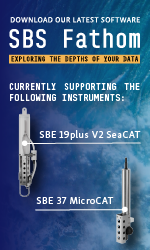- PRODUCTS
- MODEL LIST
- APPLICATIONS
- SUPPORT
- SALES/SERVICE
- BLOG
- ABOUT
Navis Autonomous Profiling Float
Autonomous profiling float for Argo and other programs
The Navis float has a traditional layout, with the sensor head at the top, and the buoyancy bladders at the bottom. The Navis buoyancy engine uses a positive displacement piston pump to transfer silicon oil from internal to external reservoirs to increase the float volume and cause it to rise. This system provides improved energy efficiency, better parking stability, and increased depth range over existing floats.
The Navis buoyancy engine is augmented at the sea surface by inflation of an air reservoir. This surface-following function provides excess buoyancy to improve surface communications. The open-loop air buoyancy system uses a seamless, natural-rubber, external bladder and oil-augmented bladder crush prevention.
At the surface, Navis uses a Garmin 15xL-W GPS to acquire positional information. It then transmits the acquired data via an Iridium Transceiver 9523. The Iridium antenna is mounted on the CTD end cap, and is supported by the CTD cell guard.
The Navis aluminum hull has a smaller diameter and length than existing floats, providing a lightweight and cost-effective package that requires less energy to operate. The float is powered by twelve lithium DD batteries in a Sea-Bird battery pack. The battery pack provides sufficient power for 300 CTD profile cycles to 2000 dbars.
- For Long-Term Deployments
- Data Quality
- Communications
- Easily Deployed
- Package Flexibility




